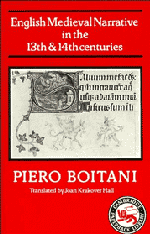3 - The World of Romance
Published online by Cambridge University Press: 04 April 2011
Summary
Preachers and writers of ‘religious’ narrative, such as Robert Mannyng, minced no words in condemning comic, amoral and dangerous compositions. With regard to the other great narrative current, that of romance, their attitude was slightly different: they fought it on its own ground, producing, as we have seen, works like the Cursor Mundi. Competition, therefore, rather than sanction: and this reveals some significant ideological and social facts. The fact that the Church did not condemn romances as ‘dangerous and foolish’ indicates that it was not too concerned about them from either a moral or a social point of view. Despite certain excesses and errors, such as the celebration of extramarital love and of violence (which were in fact censured by ecclesiastical authority), the genre was seen as fundamentally ‘sound’, and the Church felt that it could best be combated by a literature that was similar but better. Moreover, romantic literature upheld certain ideals, such as courtesy and chivalry, which could be useful to the Church and which in any case did not conflict with its teaching except on a few points. Finally, it celebrated a social order, feudalism, that had the blessing of the authorities.
Other considerations came into play: romantic literature was so widespread that it would have been impossible to ban it; above all, romances were extremely popular at all social levels, among the bourgeoisie, the aristocracy, the Court and even the masses.
- Type
- Chapter
- Information
- Publisher: Cambridge University PressPrint publication year: 1982



